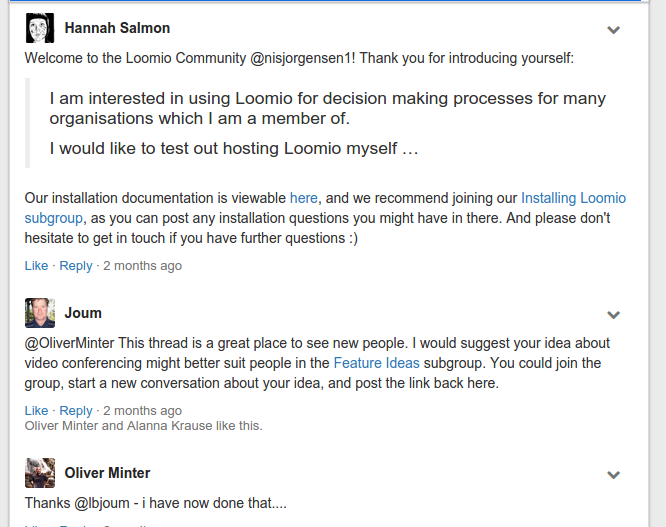Written by Simon Tegg and originally published on Medium

The internet makes massive on-line collaboration technically feasible but culturally challenging.
‘Collective intelligence’ — is the idea that groups have an intelligence of their own distinct from the sum of the participants. The dream of collective intelligence is the mass participation of a diverse group of people solving challenging problems for the common good. Collective intelligence initiatives attempt to aggregate individual contributions to enhance their collective understanding of an issue, often through software on the internet.
We could claim Wikipedia and Linux are partial massive scale collective intelligence successes (partial, because their communities are not diverse). Both of these projects have successfully aggregated massive individual contribution helping solve cheap knowledge distribution and cheap configurable computing respectively.
Another approach to collective intelligence is “Debate Mapping”. Debate mappers pool, structure and visualise on-line deliberation to highlight the areas of agreement and disagreement. The idea is that by providing a participant with a structured overview of the debate the logical
Recently, Loomio assisted two software projects, Assembl and Litemap in testing their debate-mapping software. If you’re familiar with Loomio, you’ll know that comments are presented as a simple stream:

Whereas in Assembl and Litemap discussions are structured into a hierarchy and network respectively. We tested the value that different discussion visualisations provide to particpants in online discussion and will publish these once the analysis is finalised.
Check out this example from Assembl on youth wellbeing


The most challenging part of the collaboration was engaging people and scaling them to a larger, ‘low touch’ audience. In this post I address this challenge and suggest where collective intelligence researchers might focus their efforts to overcome it.
Scaling collective intelligence
Why would a person spend their time contributing to collective intelligence?
A fundamental obstacle to scaling collective intelligence is that claimed benefit is vague and uncertain and this by itself does not provide enough motivation for most people to participate. While there are civic minded people who will contribute for social good, when the initiative depends solely on civic altruism it will struggle to scale beyond the core of committed activists and stakeholders. Initiatives are literally competing with cat gifs for people’s free time.
Participating in a successful scaled initiative solves a problem or meets some need for the contributor. It’s hard to make blanket statements about what are often diverse motivations but for our purpose we’ll divide them into social needs, individual needs and financial rewards:
Social Needs
Is there an established community? Does the community have a strong shared identity? Do they know each other personally? Do they want to coordinate collective action, or solve a pressing collective problem? Tight-knit groups are good candidates for collective problem solving.
Individuals who identify with a collective will often subordinate themselves to the needs of that collective. A collective intelligence initiative might leverage the need for social belonging so that people volunteer their time for collective benefit. To many Westerners raised on a diet of neoliberalism and Ayn Rand the previous two statements sound like the seventh circle of hell. But this can be perfectly healthy way to enhance the individual’s well being if the community is healthy. There are of course cults (unhealthy communities) that exploit the need for social belonging for the selfish ends of the cult leader.
If there is no community, you might think about starting one. This is a long, arduous, though often quite rewarding journey and requires a critical mass of core contributors with strong people skills (often undervalued).
Believing Dunbar’s number you might scale your community up to 150 members. Don’t be disappointed. Lots of problems can solved by small groups.
Individual Needs
A second, perhaps complementary, strategy is to appeal to individual needs by creating opportunities for an individual to learn skills, gain reputation, or scratch an itch. A community will still provide context for satisfying these needs, but these communities are larger, more open and broader than the tight-knit community described above. Larger communities still need active facilitation, rules, principles, and dedicated core contributors. Software features that publicise a contributor’s reputation can facilitate these self-interested contributions (such as Github’s contribution streak, or Reddit’s user karma) but cannot substitute for human efforts.
To illustrate with examples, in open source software development, super-contributors get noticed and invited to speak at conferences and often parlay their contributions into interesting and lucrative careers. A welcoming community might constructively critique a junior’s contributions, providing opportunities to learn and improve. Simple errors might motivate a ‘perfectionist’ contributor to fix the horror of a typo on a high traffic website.
This ‘social architecture’ of massive on-line collaboration is a whole area of research and practice in its own right, much broader than can be covered here. The best guides I’ve encountered for social architecture of large scale communities are Chapter 6 of the ZeroMQ Guide and the related Chapter 3 of Culture and Empire by the same author, the classic The Cathedral and The Bazaar, and Yochai Benkler’s work.
Money
A third strategy is perhaps less relevant to debate mapping. No community, just a focus on financial rewards through gambling. Prediction markets create common good collective intelligence (crowd-sourced predictions about the future that are often more accurate than individual expert opinion) from cold hard individual financial risk and reward. This is totally valid in its own right, although combining financial rewards with the other strategies risks undermining the community.
The Debate Mapping Dilemma
In the first case, does debate-mapping meet any pressing needs of tight-knit communities? Debate-mapping suits broad exploratory topics and I’m certain many communities could benefit from exploring the bigger picture and using debate mapping as a tool for their collective sense-making. The paradox is that tight-knit communities are fundamentally more inclined to maintain agreement than explore disagreement. For debate-mapping to work in the context of a tight-knit community, the community must also invest in fostering a culture of respectful disagreement alongside any formal process.
In the second case, can a contributor gain reputation in a community of peers? Can the contributor leverage this reputation for their own gain? Are there opportunities to improve a professional craft through contributing? The practice of debate mapping can improve critical thinking, but it’s not clear how this can transfer specifically into a material advantage.
The counterpoint is that if you had predicted in the 90’s that in 10 years hence internet-connected people would regularly get information from a collaborative, on-line encyclopaedia, edited by 10’s of thousands of amateur, ‘Wikipedians’, who volunteer their free labour to keep it up to date, you would have been laughed at. So it’s possible, but far from assured, that something similar could happen with debate mapping.
Conclusion
Efforts to scale collective intelligence must invest in social architecture — on-boarding, process and experience design, valuing and creating opportunities for participants at least as much, if not more, than software features.




